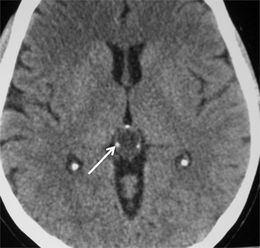Pineal parenchymal tumor with intermediate differentiation

Pineal parenchymal tumors with intermediate differentiation (PPTID) are, as the name suggests, tumors which fall between pineocytoma (well differentiated, WHO grade I) and pineoblastomas (poorly differentiated, WHO grade IV). They are considered WHO grade II or III tumors . Although these tumors are encountered at all ages, they are particularly seen in middle age adults (20-70 years of age) with slight female predilection, similar to that of pineocytomas .
Their radiographic appearance and biological behavior are also intermediate. They may invade adjacent structures and also spread along CSF and therefore imaging of the entire craniospinal axis is therefore required .
Pathology
Macroscopic appearance
Pineal parenchymal tumors with intermediate differentiation have a similar macroscopic appearance to pineocytomas, appearing relatively well circumscribed with heterogeneous cut surface .
Microscopic appearance
Two microscopic patterns are encountered, sometimes co-existing :
The lobulated pattern, poorly defined lobules are separated from each other by large fibrous vessels .
The diffuse pattern is reminiscent of oligodendrogliomas and/or central neurocytomas, with the large pineocytomatous rosettes characteristic of pineocytomas not evident .
Immunophenotype
- synaptophysin: positive
- NFP: variable
- NeuN: negative
Radiographic features
The features of pineal parenchymal tumor with intermediate differentiation range from those of pineocytomas to those of pineoblastomas, and they are therefore not repeated here.
When faced with a well-circumscribed pineal tumor with appearances of a pineocytoma, fairly rapid growth and/or low ADC values are clues that it may, in fact, represents a pineal parenchymal tumor with intermediate differentiation.
Treatment and prognosis
Like everything else about this tumor, treatment and prognosis are intermediate falling between that of pineocytomas and of pineoblastomas.
Siehe auch:
- verkalktes Corpus pineale
- Tumoren der Pinealisregion
- Pineoblastom
- Pineozytom
- Parenchymtumoren der Glandula pinealis
und weiter:

 Assoziationen und Differentialdiagnosen zu Parenchymtumor der Glandula pinealis mit intermediärer Differenzierung:
Assoziationen und Differentialdiagnosen zu Parenchymtumor der Glandula pinealis mit intermediärer Differenzierung:


